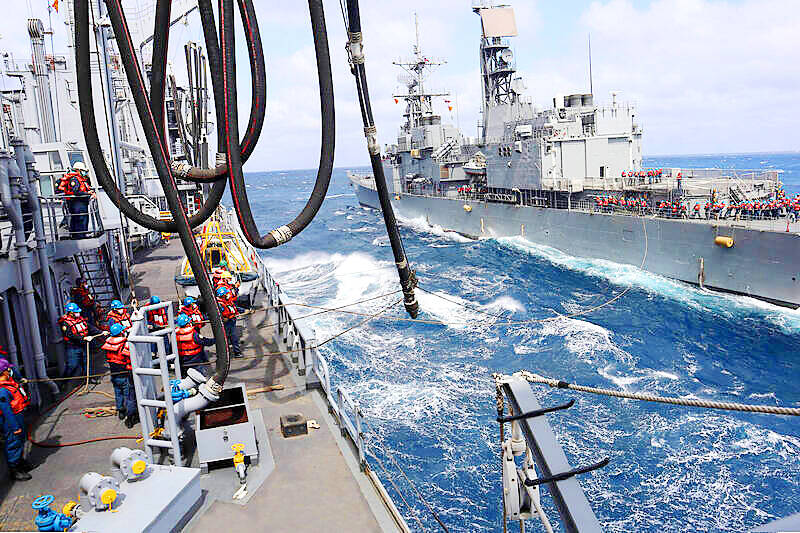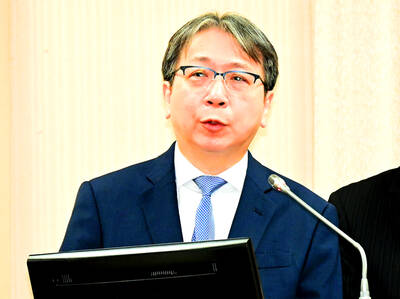The navy is next week to conduct a series of service-wide evaluations on tactics and gunnery before concluding the annual Ching Shih training exercises (精實訓練操演), sources said.
The evaluations would feature live-fire exercises with 76mm and 5-inch naval guns and simulated engagements and sorties against the Chinese People’s Liberation Army Navy (PLAN), they said.
All six of the navy’s surface warship fleets and one submarine fleet are to take part in the Ching Shih exercises, while live-fire torpedo and missile drills would be conducted later this year, the source said.

Photo courtesy of the Navy Command
The navy over the past few weeks has been conducting mock battles involving pure or mixed-fleet task forces consisting of three or four ships as part of the exercises, and next week’s activities would be the final phase, they said.
Vice Chief of the General Staff Vice Admiral Chiang Cheng-kuo (蔣正國) on Friday toured several naval facilities in Kaohsiung to inspect the exercises, the state-run Military News Agency said in a report.
He thanked service members involved in the drill, and emphasized to commanders the importance of being aware of the condition of personnel and equipment to ensure safety, the report said.
Officers of all ranks must be thoroughly familiar with the weapons systems and equipment on their ship, plan comprehensively to deal with any eventuality and test their plans during drills, he said.
In related news, the navy is expected to form a third mobile Hai Feng land-based anti-ship missile squadron by the end of the year, a separate source familiar with the matter said.
The mobile squadrons — which are equipped with Hsiung Feng II and Hsiung Feng III anti-ship missiles — and their launcher vehicles would be renamed Hai Feng Strike Groups and placed under the control of the planned Coastal Defense Operations Command, the source said, asking to remain anonymous.
The first mobile missile squadron is currently responsible for northern and central regions of Taiwan proper, as well as the nation’s outlying islands, while the second squadron is in charge of the southern and eastern regions, they said.
After the creation of a third mobile squadron, the nation’s coastal defenses would be reorganized under one of two proposed schemes: the north-central-southern plan or the south-north-eastern plan, the source said.
The first and second Hai Feng mobile squadrons are already highly involved in countering the threat posed by PLAN vessels conducting military exercises around Taiwan, resulting in added maintenance requirements, they said.
The navy has made arrangements with the Chungshan Institute of Science and Technology to maintain and repair the Hsiung Feng missile vehicles, they said.
Coastal defense anti-ship units would be armed with new weapons as they come online, including 100 vehicle-mounted Harpoon missile launchers and extended-range Hsiung Feng III missiles, some of which have reportedly entered into service in small numbers, they said.

The US government has signed defense cooperation agreements with Japan and the Philippines to boost the deterrence capabilities of countries in the first island chain, a report by the National Security Bureau (NSB) showed. The main countries on the first island chain include the two nations and Taiwan. The bureau is to present the report at a meeting of the legislature’s Foreign Affairs and National Defense Committee tomorrow. The US military has deployed Typhon missile systems to Japan’s Yamaguchi Prefecture and Zambales province in the Philippines during their joint military exercises. It has also installed NMESIS anti-ship systems in Japan’s Okinawa

TRAGEDY STRIKES TAIPEI: The suspect died after falling off a building after he threw smoke grenades into Taipei Main Station and went on a killing spree in Zhongshan A 27-year-old suspect allegedly threw smoke grenades in Taipei Main Station and then proceeded to Zhongshan MRT Station in a random killing spree that resulted in the death of the suspect and two other civilians, and seven injured, including one in critical condition, as of press time last night. The suspect, identified as a man surnamed Chang Wen (張文), allegedly began the attack at Taipei Main Station, the Taipei Fire Department said, adding that it received a report at 5:24pm that smoke grenades had been thrown in the station. One man in his 50s was rushed to hospital after a cardiac arrest

‘WIN-WIN’: The Philippines, and central and eastern European countries are important potential drone cooperation partners, Minister of Foreign Affairs Lin Chia-lung said Minister of Foreign Affairs Lin Chia-lung (林佳龍) in an interview published yesterday confirmed that there are joint ventures between Taiwan and Poland in the drone industry. Lin made the remark in an exclusive interview with the Chinese-language Liberty Times (the Taipei Times’ sister paper). The government-backed Taiwan Excellence Drone International Business Opportunities Alliance and the Polish Chamber of Unmanned Systems on Wednesday last week signed a memorandum of understanding in Poland to develop a “non-China” supply chain for drones and work together on key technologies. Asked if Taiwan prioritized Poland among central and eastern European countries in drone collaboration, Lin

ON ALERT: Taiwan’s partners would issue warnings if China attempted to use Interpol to target Taiwanese, and the global body has mechanisms to prevent it, an official said China has stationed two to four people specializing in Taiwan affairs at its embassies in several democratic countries to monitor and harass Taiwanese, actions that the host nations would not tolerate, National Security Bureau (NSB) Director-General Tsai Ming-yen (蔡明彥) said yesterday. Tsai made the comments at a meeting of the legislature’s Foreign Affairs and National Defense Committee, which asked him and Minister of National Defense Wellington Koo (顧立雄) to report on potential conflicts in the Taiwan Strait and military preparedness. Democratic Progressive Party (DPP) Legislator Michelle Lin (林楚茵) expressed concern that Beijing has posted personnel from China’s Taiwan Affairs Office to its